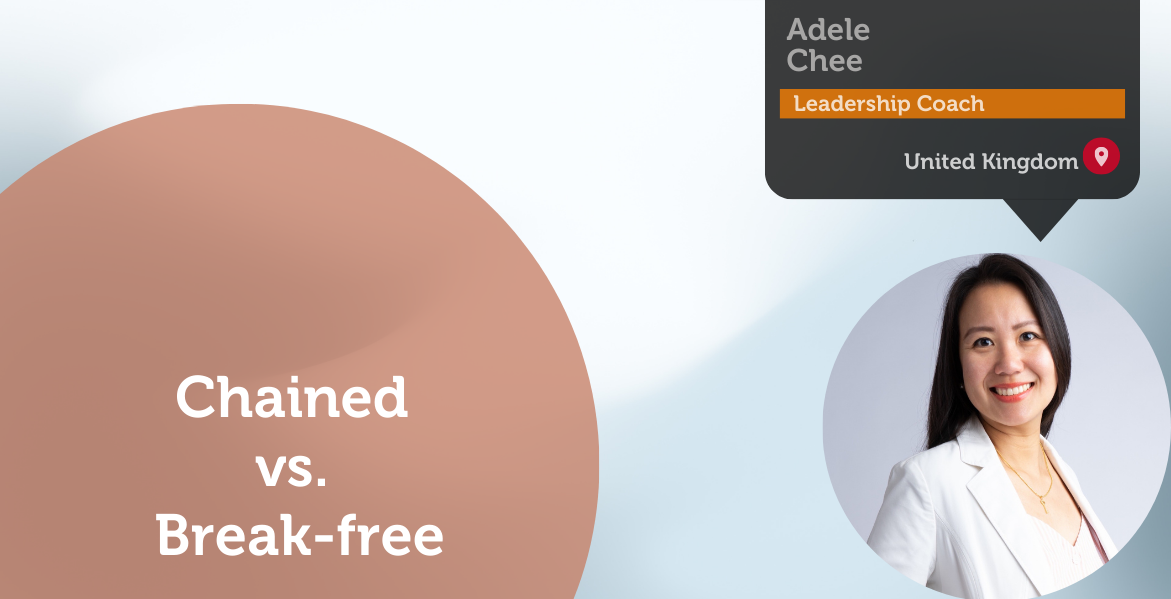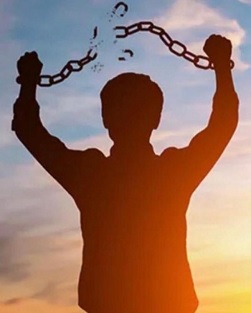A Coaching Power Tool By Adele Chee, Life & Leadership Coach, UNITED KINGDOM

 Chained vs. Break-Free Definition
Chained vs. Break-Free Definition
Chained
The definition of the word “chained” is to be confined. In a literal sense, it’s to be at someone else’s mercy. In a more philosophical sense, there are two folds: external and internal confinements. Externally, it’s to be limited by societal expectations and circumstances. Internally, it’s to be limited by our own assumptions, beliefs, and past experiences. Ultimately, feeling like you’re being chained stews fears that further tighten the chains that bind us.
The only way to break the chain is to overcome these fears.
- Fear of judgment – people who choose to limit themselves from living the life that they want and instead live the life that is expected of them
- Fear of failure, success, and the unknown – people who choose to limit themselves to live with their circumstances instead of creating possibilities to achieve the life that they want
The consequence of these fears is that one ends up not living an authentic and fulfilling life and instead, living a mundane life with a fixed mindset and constantly feeling stuck, frustrated, and discontented.
Break-free
Just having the thought of wanting to break free from the chains that have constrained you is the first step in that direction.
Keeping your thoughts plain and simple can become the fuel that you need to overcome the fears that you’re dealing with.
- Fear of judgment – “They (others) are not living my life and not paying my bills. So, why should I let their words get in the way of the life I want to live?”
- That said, know that oftentimes it’s us who are judging ourselves. We always like to think that others are always watching us and judging us. However, in reality, we are all thinking more about ourselves than others. There is numerous scientific research out there to prove this.
- This is also why a lot of times, well-meaning friends and family will give you advice that feels discouraging. They are sharing them through the lens of their own experiences and fears. So, take or disregard these wise words with a pinch of salt and apply them where they make sense for you.
- Fear of failure, success and the unknown – “Whether I fail or succeed, I will learn from the experience. When I experience and learn, I’ll know. In order to experience failure, success, and learning, I need to DO.” In the words of Herbert Spencer, “The great aim of learning is not knowledge but action.”
When you’re living a break-free life, you’re goal-focused, action-oriented, and feel more in control, authentic, and fulfilled with the life that you have.
Chained vs. Break-Free Crucial Points
Clarity
To succeed in breaking free, having clarity of what you want to achieve is the critical next step. This can then help you determine the right WHAT and WHO you’ll need to support you on your HOW.
Generally, people know what (and who) they want to break free from but not what they want to achieve. This is why they feel like they can’t break free.
- Many struggle with knowing what they want because, sometimes you just don’t know what you don’t know. In which case, start with what you know. For example, if you think that you’re working in a toxic environment, all you know is that you need to get out. However, you don’t know if the new place will be any better. Well, starting with what you know: What do you enjoy about your current environment even though it’s toxic? What did you not enjoy about your toxic environment and what do you wish it could have been like? Armed with this knowledge, when you interview at a potential new place, you can ask these questions to find your answers.
- There are also those who struggle with knowing what they want because they are spoilt for choices. Too much of a good thing can be bad at times as this leads to indecision and thus, stagnation. Having the ability to determine what could be an opportunity and what is actually a distraction requires discernment. Depending on your situation, sometimes it makes more sense to focus on the immediate priority and sometimes it could make more sense to consider a longer-term strategy. A question to ask yourself is, what is the most important thing that you need right now? This is because we’re living in the present, not in the past or in the future.
Beliefs and Mindsets
Pessimistic and negative beliefs and mindsets keep the chains on – even adding on more chains. Shifting the words that you tell yourself from something as simple as “it can’t be done” to “it can be done” will make you start to consider solutions instead of problems.
Universally, people tend to sweep their ‘big dreams’ under the carpet because they seem too big or too far out in the future to be realistically within reach. Hence, they think that it’s not achievable. This is also in part due to the current environment of instant gratification that we live in i.e. “I want to achieve X. I want X now.” So, the thought of a thousand steps to get to X is enough to put them off to take the first step, even if that first step is an easy one. What a lot of people don’t realize is that, more often than not, just taking the first step could bring a thousand steps down to 900, 500, or even 100 steps. This is because sometimes, that one step can create a ripple effect that eliminates a few steps. Therefore, refocusing your perspective that the first is easy and that the subsequent steps are the next “first” steps, will make you feel like you’ve only taken your “first step” when you achieve your goal.
Behaviors
When you have clarity of your goals and actions to take to achieve them, you need to ensure that they are in alignment with your values and purpose.
The reason many externally perceived successful people feel discontented with their lives is because there is a disconnect between who they are within and without, and what they are doing versus what they are meant to be doing. This causes them to ask questions like “Is this what I’m supposed to be doing with my life?”, “Surely there is more to life than this?” and “I have everything that I can humanly want, yet why do I feel empty?”
In a way, they are feeling not in control, inauthentic, and unfulfilled with their way of life despite all the accolades that they have under their belt. In other words, they are bound by the elements that make up their lives and don’t have the freedom to let their lives shine in their natural form, making them feel trapped and longing for something more.
Bringing this Chained vs. Break-free concept full circle, I’m going to contradict this concept by saying, chain your mind, emotion, and will to your core – that is, your values and purpose. This can help you break free from all other components that are not you and achieve your vision, not that of others. When you’re able to do this, you will realize that you are enough, you have more than enough and you can just be.
Application in Coaching: Case Studies
Client A
Client A was having a hard time dealing with a challenging colleague – it’s at the point where she dreads waking up to go to work if there’s a meeting with this colleague in the diary on that day. Leveraging this Chained vs. Break-free power tool and Stephen Covey’s Circles of Control, Influence, and Acceptance model, she said that she can clearly see what’s happening between them and can differentiate her options i.e. what’s within her circle of control. She also went on to say that she’s no longer afraid of having a much-needed discussion with this colleague and is in fact, looking forward to their next meeting. She also feels confident that she will have a successful meeting with this colleague, leaning on the thought that “he doesn’t pay her bills.”
Client B
Client B was feeling jaded about her life in the corporate space and was contemplating starting her own business. Using the Chained vs. Break-free power tool, she had better clarity of her circumstances and priorities as well as the real chains that were weighing her down. She discovered that it wasn’t the corporate arena that was suffocating her, it was the working environment of the industry and organization that she was in. Also, she acknowledged her self-limiting belief that she only has experience in this particular industry, hence her options are limited. These realizations gave her the courage to explore opportunities in different industries, still within the corporate landscape. When she landed her new job, she told me, “I’ve got my mojo back!”
Client C
Client C experienced a wholesome upbringing by way of being raised by parents who are like Dr. Jekyll and Mr. Hyde, enduring torment and endearment intermittently throughout the day, every day, for nearly three decades. Her fear of judgment prevented her from reporting her parents to authorities. In particular, the thought of how the shame of her parents being reported to authorities affects other members of her family. So, she played the role of a filial child. Using the Chained vs. Break-free power tool, she realized that she doesn’t owe her life to anyone but herself. This led her to take accountability and put steps in place to ensure that she lives life by her design. Hence, she went from being at someone else’s mercy to living a fulfilling life where she has the freedom of choice to achieve her own goals, on her own terms – where she is independent financially, physically, psychologically, and emotionally as well as vocally; being in a relationship with someone who respects her and share her values; and having a healthy mind, body, soul, and spirit, taking the good and bad past experiences as life lessons that have allowed her to grow and evolve into the person that she is today.